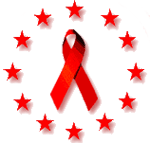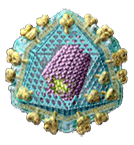|
|
 |
| Home
> Health
Care > Others
> HIV and AIDS |
| |
| The History of AIDS and HIV |
 In
1978, gay men in the United States and Sweden as
well as heterosexuals in Tanzania and Haiti, began
showing signs of what will later be called AIDS.
Three years later, approximately 31 people died
of the diseases in the United States. In
1978, gay men in the United States and Sweden as
well as heterosexuals in Tanzania and Haiti, began
showing signs of what will later be called AIDS.
Three years later, approximately 31 people died
of the diseases in the United States.
The term AIDS (Acquired Immune
Deficiency Syndrome) is used for the first
time on 27 July 1982. Number of people who died
of the diseases in USA increased to 853 people.
In 1983, Institut Pasteur in France discovered the
virus that causes AIDS, which is called HIV (Human
Immunodeficiency Virus). In 1987, the first
anti-HIV drug, AZT, was approved for use in the
United States. But six years later, researchers
in Europe proved taking AZT (monotherapy)
early in the disease has no benefits.
In 1995, the first anti-HIV drug in the protease
inhibitor class, Saquinavir, was approved for use
in the United States. The following year, a number
of drugs such as Nevirapine, Ritonavir, Indinavir,
were also approved for use in USA.
By 1997, approximately 22,000,000 people were HIV-positive
and 6,400,000 people had died of the disease throughout
the world. |
| |
HIV (Human
Immunodeficiency Virus)
A virus is a germ that requires a host cell to survive
and reproduce. Viruses are highly adaptable, with
the potential of remaining alive in their host cells
for long period of time.
Human Immunodeficiency Virus (HIV)
is a highly adaptable virus capable of mutating
quickly. It affects only human and needs human cells
to thrive and reproduce. Related viruses affect
other species in similar ways, for example Feline
Immunodeficiency Virus (FIV)
that affects cats.
HIV weakens the immune system by invading specific
healthy white blood cells (T-Cells
or CD4 cells), and destroys them in order
to reproduce itself. These T-Cells play an important
role in the way to fight off the diseases and infections
in our body.
When HIV starts reproducing itself in one's body,
it destroys the immune defenses, making it easier
to get sick and harder to recover from diseases.
|
| |
| HIV Destroys the Immune System |
HIV-positive people are the ones
who have been tested and found to have signs of
the human immunodeficiency virus in their blood.
HIV destroys part of the immune system. Specifically,
it affects a type of white blood cells called the
T lymphocyte (T-cell).
T-cells are one type of fighter cell in the blood
that help the body fight off all kinds of germs
and diseases.
After HIV enters the body, it goes into a T-cell
and works its way inside of that cell. Once inside,
the virus completely takes over the T-cell and multiplies
itself.
The new viruses then leave the T-cell and go on
to infect and destroy other healthy T-cells as they
continue to multiply inside the body. After the
virus invades the T-cells, the T-cells can no longer
properly fight infections.
Someone who is infected with the virus is called
HIV-positive. But it may take years for the virus
to damage enough T-cells for that person to get
sick and develop AIDS. Through new medications,
someone infected with HIV can stay relatively healthy
and symptom-free for many years.
 Although
the HIV-positive person may feel fine, the HIV virus
is silently multiplied itself and destroying T-cells.
During this period, the person is still contagious,
which means he or she is able to infect others. Although
the HIV-positive person may feel fine, the HIV virus
is silently multiplied itself and destroying T-cells.
During this period, the person is still contagious,
which means he or she is able to infect others.
When one's immune system has weakened and more of
the blood's T cells have been destroyed by the virus,
the person can no longer fight off infections and
gets very sick. A person is diagnosed with AIDS
when he or she has a very low number of T cells
and shows signs of a serious infection. |
| |
| Number of People Who Infected
HIV and AIDS |
Since the discovery of the HIV virus
in 1983, millions of people throughout the world
have been infected with HIV. Today, AIDS is still
an epidemic, which means that it affects a large
number of people and continues to spread rapidly.
At present, approximately 40 million people in the
world are living with HIV infection or AIDS. This
includes 37 million adults and 2.5 million children.
|
| |
| The Spread of HIV |
| HIV infection isn't like a cold
or flu. A person cannot get HIV by hugging, holding
the hand of, or visiting the home of someone who
has HIV. HIV is passed only through direct contact
with another person's body fluids, such as blood.
The majority of people get infected with HIV by: |
| • |
having sexual contact with a person who
has HIV |
| • |
sharing needles with a person who has HIV |
|
| |
| HIV can also spread by following
ways: |
| • |
an HIV-positive pregnant woman who passes
it to her unborn child. That is why, every
pregnant woman should be tested for HIV |
| • |
a person who receives a blood transfusion
from a fairly large volume of blood that was
not tested for HIV |
|
| |
| The Symptoms of HIV and AIDS |
Most people don't feel any different
after they are infected with HIV. In fact, infected
people often do not experience symptoms for years.
Some people has flu-like symptoms a few days to
a few weeks after being infected, but these symptoms
usually disappear after several days.
An HIV-positive person will eventually begin to
feel sick. The person might begin to have swollen
lymph nodes, weight loss, fevers that come and go,
infections in the mouth, diarrhea, or he or she
might always feel tired for no reason.
When a person's T-cell number gets very low, the
immune system is so weak that many different diseases
and infections by other germs can develop. These
can be life threatening. For example, people with
AIDS often develop pneumonia, which causes bad coughing
and breathing problems. Other infections can affect
the eyes, the digestive system's organs, the kidneys,
the lungs, and the brain. Some people develop rare
kinds of cancers of the skin or immune system. |
| |
| The Way of Diagnosing HIV and
AIDS |
A person can be infected with HIV
without even knowing it. So, it is recommended that
anyone who thinks he or she may have been exposed
to the virus get tested.
HIV-positive people need to have more blood tests
often. The doctor will check on how many T-cells
the person has. The lower the T-cell number, the
weaker the immune system, and the greater the risk
of getting very sick. |
| |
| The Treatments of HIV and AIDS |
| At present, there is no cure for
HIV or AIDS, but new medicines can help people live
longer lives. Scientists are also researching vaccines
that may one day help to prevent HIV infection.
It's up to everyone to prevent AIDS by avoiding
the behaviors that lead to HIV infection. |
| |
| HIV and AIDS Prevention |
People can help stopping the spread
of HIV by avoiding sexual contact with infected
people and by not sharing needles or syringes.
Health care workers such as doctors, nurses, and
dentists, help preventing the spread of HIV by wearing
plastic gloves when working on a patient.
Hospitals must have strict procedures for handling
samples of blood and other body fluids to prevent
others from infecting with HIV. |
| |
| Living With HIV and AIDS |
New medications make it possible
for HIV-positive people to live for years without
getting AIDS. They will have to take certain medicines
every day and go to their doctors often, and they
may get sick more than other people do because their
immune systems are more fragile.
Even though they may look OK, HIV-positive people
may sometimes feel scared, angry, unhappy, or depressed.
They may feel afraid that other the people could
find out and start treating them differently. It
is important for us to remember that usual social
contact with HIV-positive people does not bring
any risk of infection.
When HIV infection gets worse or turns into the
disease called AIDS, the person may need to spend
a lot of time in bed or in the hospital because
of serious illnesses. He or she may feel very tired
or weak most of the time and also might lose weight. |
| |
| Hope for an HIV-Free Future |
| Maybe one day, a cure for HIV infection
will be found and AIDS will no longer exist. Until
then, the smartest thing to do is to know the facts
and not put yourself at risk. |
| |
|
 |
|
|
